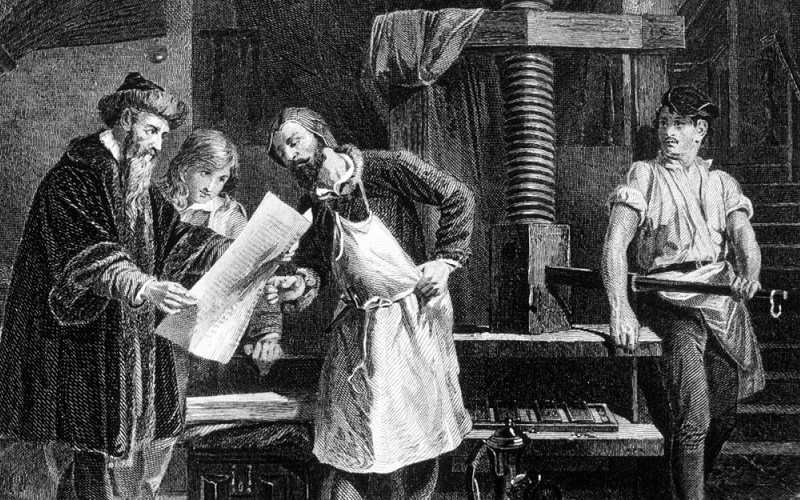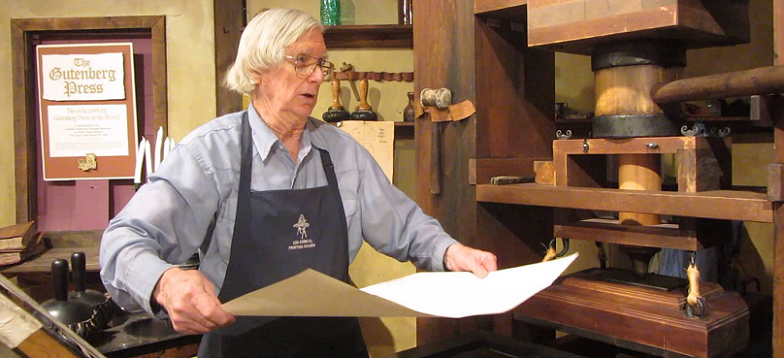
When Johannes Gutenberg invented the printing press in the 15th century, he revolutionized the world of knowledge dissemination forever. The printing press allowed for the mass production of books, pamphlets, and other materials, making it possible to distribute information on a scale never before seen. Gutenberg’s invention transformed the world in countless ways, from the spread of scientific knowledge to the democratization of education and the growth of the modern economy.
What Is the Gutenberg Printing Press?
The Gutenberg printing press is a machine invented in the 15th century by Johannes Gutenberg. It used movable type and allowed for the mass production of books, pamphlets, and other printed materials. This invention marked a significant advancement in printing technology and was a major contributor to the growth of knowledge dissemination, literacy, and the spread of scientific knowledge.
The printing press also democratized access to education, as books and other printed materials could be produced on a large scale, making them more affordable and widely available. The impact of the Gutenberg printing press was profound, and it is widely regarded as one of the most important inventions in human history.
Historical Context of Printing Before the Gutenberg Press
Before the Gutenberg printing press, printing was done by hand using woodblock printing or engraving. These methods were labor-intensive, slow, and expensive, making books and other printed materials accessible only to the wealthy. The printing industry was limited to a few regions in the world, and there was no standardized printing system.
Printed materials were scarce, and only a select few had access to them. The scarcity of printed materials also led to a lack of standardization in language and spelling. The majority of the population was illiterate, and books were rare and expensive.
The Renaissance period brought about an increase in the demand for books, which created a need for a more efficient printing method. The historical context of printing before the Gutenberg press was one of limited access, high cost, and a lack of standardization. Gutenberg’s invention changed all of that and transformed the printing industry forever.

Gutenberg’s Printing Press Invention
The Gutenberg printing press was a revolutionary invention that transformed the world of printing and bookmaking. The press consisted of a wooden frame that supported a movable type tray. The type tray contained individual metal letters, numbers, and punctuation marks that could be arranged in various combinations to form words, phrases, and sentences. The tray was then inked, and the paper was placed on top of it. A screw, which was turned by hand, pressed the paper against the inked type, transferring the ink to the paper and leaving a printed impression.
One of the key innovations of Gutenberg’s printing press was the use of adjustable type. Unlike previous printing techniques, which used carved woodblocks or metal plates that were fixed in place, the movable type system allowed printers to easily change and rearrange the type to form different combinations of letters and words. This made the printing process more efficient and allowed for faster production of printed materials.
Gutenberg’s printing press also featured a range of other innovations that made it more durable and efficient than previous printing presses. For example, the use of metal type made it possible to produce sharper and more precise printed text, while the screw mechanism provided greater control and consistency in the printing process. The use of oil-based ink helped to produce a more vibrant and lasting print.

Gutenberg’s Printing Press Impact on the World
Gutenberg’s printing press had a profound impact on the world and helped to revolutionize the way knowledge was disseminated. The printing press made it possible to produce books and other printed materials more quickly, efficiently, and cheaply than ever before, making these materials more widely available to a larger portion of the population.
Gutenberg’s Printing Press Impact on Education and Literacy
One of the most significant impacts of the printing press was on education and literacy. With the increased availability of printed materials, more people were able to learn to read and access information. This, in turn, contributed to the growth of science, philosophy, and the arts. It also encourage fiction writing and other storytelling. The printing press also allowed for the dissemination of standardized language, spelling, and grammar, which helped to promote the development of national and regional identities.
Gutenberg’s Printing Press Impact on Economics
In addition to its impact on education and literacy, the printing press had a significant economic impact. With the ability to produce books and other printed materials more efficiently, the printing industry expanded rapidly, creating new jobs and new opportunities for entrepreneurs. The printing press also helped to drive the growth of the publishing industry, making it possible for authors to reach a wider audience and making it easier for publishers to produce and distribute their work.
Gutenberg’s Printing Press Impact on Culture and Religion
The cultural and religious impact of the printing press was also profound. The printing press made it possible to disseminate religious texts more widely, which helped to spread the ideas of the Reformation and led to the establishment of new churches and religious movements. The printing press also helped to spread ideas and knowledge more broadly, leading to the growth of humanist thought and the Enlightenment.
The printing press was a revolutionary invention that had a significant impact on the world. By democratizing access to knowledge and facilitating the dissemination of new ideas and information, the printing press played a key role in the development of modern society, science, and culture.

Legacy of Gutenberg’s Printing Press
The legacy of Gutenberg’s printing press is far-reaching and has had a lasting impact on the world. Perhaps one of the most significant aspects of the printing press’s legacy is its role in the democratization of knowledge. The printing press made it possible to produce books and other printed materials more quickly, efficiently, and cheaply than ever before, making these materials more widely available to a larger portion of the population.
The printing press also helped to create new industries and new opportunities for entrepreneurs. The printing industry grew rapidly, creating jobs for printers, bookbinders, paper makers, and others. The printing press also helped to drive the growth of the publishing industry, making it possible for authors to reach a wider audience and making it easier for publishers to produce and distribute their work.
The printing press had a significant impact on the development of science, philosophy, and the arts. By facilitating the dissemination of new ideas and information, the printing press helped to drive the growth of knowledge and the advancement of human thought. The printing press also helped to standardize language, spelling, and grammar, which helped to promote the development of national and regional identities.
The influence of Gutenberg’s printing press can still be felt today. The printing press paved the way for many of the technological innovations that have transformed our world, from the steam-powered press to the digital revolution. The legacy of the printing press is also evident in our modern economy, where the production and dissemination of information have become key drivers of growth and innovation.
The legacy of Gutenberg’s printing press is one of innovation, democratization, and advancement. By transforming the way knowledge is disseminated, the printing press helped to shape the modern world and paved the way for many of the advances and achievements that we take for granted today.
